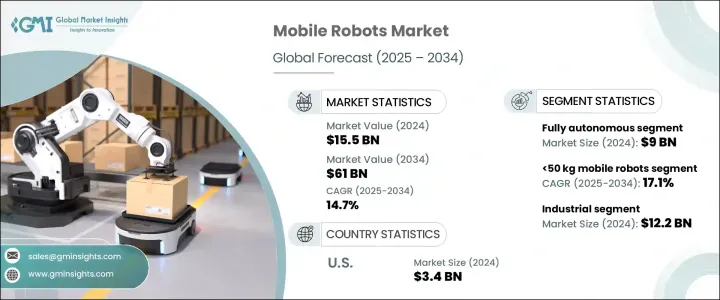
|
시장보고서
상품코드
1755285
세계의 모바일 로봇 시장 : 기회, 성장 촉진요인, 산업 동향 분석 및 예측(2025-2034년)Mobile Robots Market Opportunity, Growth Drivers, Industry Trend Analysis, and Forecast 2025 - 2034 |
||||||
세계의 모바일 로봇 시장 규모는 2024년에는 155억 달러로, 2034년에는 CAGR 14.7%로 성장하여 610억 달러에 이를 것으로 추정되고 있습니다. 이러한 인력 부족으로 기업들은 반복적인 작업, 주문 처리 및 자재 취급을 위한 로봇 솔루션을 도입하고 있습니다. 트럼프 행정부 시절 로봇 부품에 대한 관세 부과로 미국 기업들의 제조 비용이 급증했으며, 이는 중소기업(SME)에서 자율주행 모바일 로봇(AMR)과 자동 안내 차량(AGV)의 도입을 지연시켰습니다.

이로 인해 제조업체들은 공급망을 다각화하고 생산을 다른 지역으로 이전하며 제조 활동을 재개했습니다. 장기적으로 이러한 전략은 무역 위험을 완화하기 위해 지역 허브를 구축함으로써 공급망의 회복력을 강화하는 데 도움이 되었습니다. 선진국의 최저 임금 상승은 로봇 솔루션에 대한 투자 수익을 정당화하여 모바일 로봇의 채택을 더욱 강화하고 있습니다. 계절에 따라 수요가 급증하는 전자상거래와 같은 산업은 확장성을 위해 모바일 로봇에 의존하고 있으며, 이러한 동향은 노동력 부족이 점점 더 심각한 문제인 일본과 독일과 같은 고령화 사회에서 특히 두드러지게 나타납니다.
| 시장 범위 | |
|---|---|
| 시작 연도 | 2024년 |
| 예측 연도 | 2025-2034년 |
| 시작 금액 | 155억 달러 |
| 예측 금액 | 610억 달러 |
| CAGR | 14.7% |
완전 자율 모바일 로봇 부문은 2024년에 90억 달러의 가치를 기록했으며, 여전히 지배적인 부문을 차지하고 있습니다. 이 로봇들은 AI와 머신러닝을 활용해 인간 개입 없이 실시간 결정을 내릴 수 있어 창고나 병원 같은 동적 환경에 적합합니다. 이들은 고급 센서와 SLAM(동시 위치 추정 및 매핑) 기술을 활용해 복잡한 공간을 탐색합니다. 완전히 자동화된 시설인 '라이트아웃 창고'의 확산은 특히 아시아태평양과 북미 지역에서 AMR 채택을 가속화했습니다. 그러나 인간과 같은 손재주가 필요한 응용 분야에서는 여전히 과제가 남아 있어 컴퓨터 비전 및 적응형 그리퍼와 같은 첨단 기술에 대한 투자가 촉진되고 있습니다.
50-500kg의 탑재 하중을 가진 모바일 로봇 시장은 2024년에 74억 달러 규모로 평가되었으며, 이는 다양한 산업 분야에서 널리 사용되고 있음을 반영합니다. 이러한 로봇은 창고에서 자재를 취급하고, 제조 환경에서 무거운 부품을 운반하고, 병원에서 대형 장비를 이동하는 데 필수적입니다. 이 로봇들은 경량 로봇과 산업용 중량급 로봇 사이의 중요한 연결 고리 역할을 하며, 중간급 적재량을 처리하는 데 있어 유연성을 갖추고 있습니다. 산업 분야에서의 자동화 확대에 따라 이 카테고리의 모바일 로봇은 운영 효율성을 높이고 업무 프로세스를 최적화하는 데 점점 더 중요한 역할을 하고 있습니다.
미국의 모바일 로봇 시장은 인력 부족, 최저 임금 상승, 물류, 의료, 소매 등 다양한 분야에서 자동화 기술에 대한 관심이 높아짐에 따라 2024년에 34억 달러 규모로 성장할 것으로 전망됩니다. 높은 인건비와 운영 효율성에 대한 요구가 증가함에 따라, 산업계는 모바일 로봇을 사용하여 공급망 및 자재 취급 프로세스를 최적화하고 있습니다. 미국 시장은 로봇공학 분야의 혁신을 촉진하는 정부 정책과 지원 조치로부터도 혜택을 받고 있으며, 이는 기업들이 생산성을 향상시키고 인간 노동력에 대한 의존도를 줄이는 데 기여하고 있습니다.
세계의 모바일 로봇 산업의 주요 기업으로는 KUKA AG, ABB, Hikrobot Co. Ltd., Teradyne Inc., Geek 등이 있습니다. 모바일 로봇 산업에 종사하는 기업들은 시장 지위를 강화하기 위해 여러 가지 전략에 집중하고 있습니다. 주요 접근 방법 중 하나는 AI, 기계 학습, 첨단 센서 등 최신 기술을 로봇 솔루션에 통합하여 제품 포트폴리오를 확장하는 것입니다. 기업들은 무역 위험을 완화하고 국제 공급망에 대한 의존도를 줄이기 위해 제조 운영을 현지화하는 데도 점점 더 집중하고 있습니다. 또한 많은 기업들이 물류, 전자상거래, 제조업 분야의 선도 기업들과 협력해 로봇을 특정 산업 요구사항에 맞게 맞춤형으로 개발하고 있습니다. 연구개발(R&D) 투자도 필수적인 전략으로, 자율 주행, 정밀 조작, 인간-로봇 상호작용 분야의 혁신을 통해 경쟁 우위를 유지하는 데 기여하고 있습니다.
목차
제1장 조사 방법과 범위
제2장 주요 요약
제3장 산업 고찰
- 생태계 분석
- 트럼프 정권의 관세 분석
- 무역에 미치는 영향
- 무역량의 혼란
- 보복 조치
- 산업에 미치는 영향
- 공급측의 영향
- 가격 변동
- 공급망 재구성
- 생산 비용에 미치는 영향
- 수요측에 대한 영향
- 최종 시장에의 가격 전달
- 시장 점유율 동향
- 소비자의 반응 패턴
- 공급측의 영향
- 영향을 받는 주요 기업
- 전략적인 산업 대응
- 공급망 재구성
- 가격 설정 및 제품 전략
- 시책관여
- 전망과 향후 검토 사항
- 무역에 미치는 영향
- 산업에 미치는 영향요인
- 성장 촉진요인
- 노동력 부족과 인건비 상승
- 전자상거래 성장과 창고 자동화
- AI와 센서 기술의 진보
- 규제지원과 Industry 4.0의 대처
- 산업의 잠재적 리스크 및 과제
- 높은 초기 투자 비용
- 숙련된 운영자 부족
- 성장 촉진요인
- 성장 가능성 분석
- 규제 상황
- 기술
- 장래 시장 동향
- 갭 분석
- Porter's Five Forces 분석
- PESTEL 분석
제4장 경쟁 구도
- 소개
- 기업의 시장 점유율 분석
- 주요 시장 기업의 경쟁 분석
- 경쟁 포지셔닝 매트릭스
- 전략 대시보드
제5장 시장 추정 및 예측 : 자동화 레벨별(2021-2034년)
- 주요 동향
- 완전 자율
- 반자율
- 수동형(원격조작 차량)
제6장 시장 추정 및 예측 : 적재량별(2021-2034년)
- 주요 동향
- 50kg 이하
- 50-500 kg
- 500-1,000 kg
- 1,000kg 이상
제7장 시장 추정 및 예측 : 최종 용도별(2021-2034년)
- 주요 동향
- 주거
- 상업
- 산업
제8장 시장 추정 및 예측 : 지역별(2021-2034년)
- 주요 동향
- 북미
- 미국
- 캐나다
- 유럽
- 독일
- 영국
- 프랑스
- 스페인
- 이탈리아
- 네덜란드
- 아시아태평양
- 중국
- 인도
- 일본
- 호주
- 한국
- 라틴아메리카
- 브라질
- 멕시코
- 아르헨티나
- 중동 및 아프리카
- 사우디아라비아
- 남아프리카
- 아랍에미리트(UAE)
제9장 기업 프로파일
- ABB
- KUKA AG
- Boston Dynamics
- OMRON Corporation
- Yaskawa America, Inc.
- Universal Robots A/S
- Seiko Epson Corporation
- FANUC America Corporation
- Teradyne Inc.
- Geek
- Hikrobot Co., Ltd.
- Locus Robotics
- Ocado Group plc.
- Rockwell Automation, Inc.
- Vecna Robotics
- Agility Robotics
The Global Mobile Robots Market was valued at USD 15.5 billion in 2024 and is estimated to grow at a CAGR of 14.7% to reach USD 61 billion by 2034, driven by the global shortage of skilled labor, especially in manufacturing and logistics. This shortage encourages businesses to adopt robotic solutions for handling repetitive tasks, order fulfillment, and material handling. The imposition of tariffs on robotic components during the Trump administration led to a spike in manufacturing costs for U.S. companies, which slowed the adoption of autonomous mobile robots (AMRs) and automated guided vehicles (AGVs) in small and medium-sized enterprises (SMEs).

As a result, manufacturers diversified their supply chains, shifted production to other regions, and restored manufacturing activities. In the long run, these strategies helped strengthen supply chain resilience by establishing regional hubs to mitigate trade risks. The adoption of mobile robots is further bolstered by rising minimum wages in developed economies, justifying the return on investment for robotic solutions. Industries like e-commerce, which experience seasonal demand surges, rely on mobile robots for scalability, a trend seen particularly in aging societies like Japan and Germany, where the labor gap is a growing concern.
| Market Scope | |
|---|---|
| Start Year | 2024 |
| Forecast Year | 2025-2034 |
| Start Value | $15.5 Billion |
| Forecast Value | $61 Billion |
| CAGR | 14.7% |
The fully autonomous mobile robot segment was valued at USD 9 billion in 2024 and remains a dominant segment. These robots, which leverage AI and machine learning, can make real-time decisions without human input, making them ideal for dynamic environments like warehouses and hospitals. They navigate complex spaces using advanced sensors and SLAM (Simultaneous Localization and Mapping) technology. The rise of fully automated facilities, known as lights-out warehouses, accelerated the adoption of AMRs, particularly in Asia-Pacific and North America. However, challenges remain in applications requiring human-like dexterity, driving investments in advanced technologies like computer vision and adaptive grippers.
The mobile robots market with a payload capacity of 50-500 kg segment was valued at USD 7.4 billion in 2024, reflecting their widespread application in various industries. These robots are essential for material handling in warehouses, facilitating the transport of heavy components in manufacturing environments, and moving large equipment in hospitals. The versatility of these robots in handling mid-range payloads makes them a critical link between lightweight robots used for smaller tasks and heavy-duty robots designed for more industrial-scale operations. As automation continues to expand in industrial sectors, this category of mobile robots is playing an increasingly vital role in streamlining operations and improving efficiency.
United States Mobile Robot Market reached USD 3.4 billion in 2024, driven by a combination of labor shortages, rising minimum wages, and growing interest in automation technologies across sectors such as logistics, healthcare, and retail. With high labor costs and an increasing need for operational efficiency, industries use mobile robots to optimize their supply chain and material handling processes. The U.S. market has also benefited from government initiatives and policies that foster innovation in robotics, helping companies improve productivity and reduce reliance on human labor.
Some leading players in the Global Mobile Robots Industry include KUKA AG, ABB, Hikrobot Co., Ltd., Teradyne Inc., and Geek+. To strengthen their market position, companies in the mobile robots industry are focusing on several strategies. One key approach is expanding their product portfolio by integrating cutting-edge technologies such as AI, machine learning, and advanced sensors into their robotic solutions. Companies are also increasingly localizing their manufacturing operations to mitigate trade risks and reduce reliance on international supply chains. Additionally, many partners with industry leaders in logistics, e-commerce, and manufacturing to tailor their robots to specific industry needs. Investment in R&D is another essential strategy, enabling companies to stay ahead of the curve with innovations in autonomous navigation, dexterity, and human-robot interaction.
Table of Contents
Chapter 1 Methodology and Scope
- 1.1 Market scope and definitions
- 1.2 Research design
- 1.2.1 Research approach
- 1.2.2 Data collection methods
- 1.3 Base estimates and calculations
- 1.3.1 Base year calculation
- 1.3.2 Key trends for market estimation
- 1.4 Forecast model
- 1.5 Primary research and validation
- 1.5.1 Primary sources
- 1.5.2 Data mining sources
Chapter 2 Executive Summary
- 2.1 Industry 3600 synopsis
Chapter 3 Industry Insights
- 3.1 Industry ecosystem analysis
- 3.2 Trump administration tariffs analysis
- 3.2.1 Impact on trade
- 3.2.1.1 Trade volume disruptions
- 3.2.1.2 Retaliatory measures
- 3.2.2 Impact on the industry
- 3.2.2.1 Supply-side impact
- 3.2.2.1.1 Price volatility
- 3.2.2.1.2 Supply chain restructuring
- 3.2.2.1.3 Production cost implications
- 3.2.2.2 Demand-side impact
- 3.2.2.2.1 Price transmission to end markets
- 3.2.2.2.2 Market share dynamics
- 3.2.2.2.3 Consumer response patterns
- 3.2.2.1 Supply-side impact
- 3.2.3 Key companies impacted
- 3.2.4 Strategic industry responses
- 3.2.4.1 Supply chain reconfiguration
- 3.2.4.2 Pricing and product strategies
- 3.2.4.3 Policy engagement
- 3.2.5 Outlook and future considerations
- 3.2.1 Impact on trade
- 3.3 Industry impact forces
- 3.3.1 Growth drivers
- 3.3.1.1 Labor shortages and rising workforce costs
- 3.3.1.2 E-commerce growth and warehouse automation
- 3.3.1.3 Advancements in AI and sensor technologies
- 3.3.1.4 Regulatory support and industry 4.0 initiatives
- 3.3.2 Industry pitfalls and challenges
- 3.3.2.1 High initial investment costs
- 3.3.2.2 Lack of skilled operators
- 3.3.1 Growth drivers
- 3.4 Growth potential analysis
- 3.5 Regulatory landscape
- 3.6 Technology landscape
- 3.7 Future market trends
- 3.8 Gap analysis
- 3.9 Porter's analysis
- 3.10 PESTEL analysis
Chapter 4 Competitive Landscape, 2024
- 4.1 Introduction
- 4.2 Company market share analysis
- 4.3 Competitive analysis of major market players
- 4.4 Competitive positioning matrix
- 4.5 Strategy dashboard
Chapter 5 Market Estimates & Forecast, By Automation Level, 2021 - 2034 (USD Billion & Thousand Units)
- 5.1 Key trends
- 5.2 Fully autonomous
- 5.3 Semi-autonomous
- 5.4 Manual (remotely operated vehicle)
Chapter 6 Market Estimates & Forecast, By Payload Capacity, 2021 - 2034 (USD Billion & Thousand Units)
- 6.1 Key trends
- 6.2 <50 kg
- 6.3 50–500 kg
- 6.4 500–1000 kg
- 6.5 >1000 kg
Chapter 7 Market Estimates & Forecast, By End Use, 2021 - 2034 (USD Billion & Thousand Units)
- 7.1 Key trends
- 7.2 Residential/domestic
- 7.3 Commercial places
- 7.4 Industrial
Chapter 8 Market Estimates and Forecast, By Region, 2021 - 2034 (USD Billion & Thousand Units)
- 8.1 Key trends
- 8.2 North America
- 8.2.1 U.S.
- 8.2.2 Canada
- 8.3 Europe
- 8.3.1 Germany
- 8.3.2 UK
- 8.3.3 France
- 8.3.4 Spain
- 8.3.5 Italy
- 8.3.6 Netherlands
- 8.4 Asia Pacific
- 8.4.1 China
- 8.4.2 India
- 8.4.3 Japan
- 8.4.4 Australia
- 8.4.5 South Korea
- 8.5 Latin America
- 8.5.1 Brazil
- 8.5.2 Mexico
- 8.5.3 Argentina
- 8.6 Middle East and Africa
- 8.6.1 Saudi Arabia
- 8.6.2 South Africa
- 8.6.3 UAE
Chapter 9 Company Profiles
- 9.1 ABB
- 9.2 KUKA AG
- 9.3 Boston Dynamics
- 9.4 OMRON Corporation
- 9.5 Yaskawa America, Inc.
- 9.6 Universal Robots A/S
- 9.7 Seiko Epson Corporation
- 9.8 FANUC America Corporation
- 9.9 Teradyne Inc.
- 9.10 Geek+
- 9.11 Hikrobot Co., Ltd.
- 9.12 Locus Robotics
- 9.13 Ocado Group plc.
- 9.14 Rockwell Automation, Inc.
- 9.15 Vecna Robotics
- 9.16 Agility Robotics



















